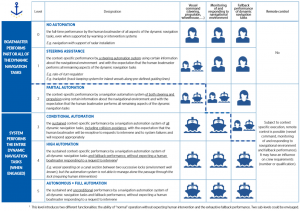FIRST INTERNATIONAL DEFINITION OF LEVELS OF AUTOMATION IN INLAND NAVIGATION
Published: Januar 10, 2019

Source: CCNR Press release 19 December 2018. During its plenary meeting in December, the CCNR adopted a first international definition of levels of automation in navigation. This definition enables us to arrive at a clear understanding of automated navigation as a whole.

CONTEXT
Progressive automation, seen in numerous technical applications, including inland navigation, has increasingly important implications, which require changes to the existing social and legal frameworks.
Automated navigation now covers a wide spectrum of technical processes and there are numerous use cases, ranging from simple assistance to fully automatic navigation. The level of automation is therefore the variable that offers the best understanding of the concept of automation.
In principle, automating certain tasks makes for the potential replacement of man by machine. In inland navigation, automation does indeed make life easier for boatmen by lightening the load on the boatmaster, but also raises questions about maintaining safety levels and possible concerns about its scope, namely the level of automation.
The CCNR therefore wants to start by defining levels of automation with a view to kick-starting a general discussion on the increasing prevalence of automation in inland navigation and to understanding the opportunity for adopting regulatory measures.
NEED FOR A DEFINITION OF AUTOMATION LEVELS
Automation is currently impacting the different modes of transport, be it air, sea, road and rail freight. As with maritime or road transport, recent technological developments to do with automated navigation come in for particular scrutiny by the inland navigation sector. National and international inland navigation research projects, such as LAESSI, RAVEN or NOVIMAR are attempting to innovate by developing more automated navigation. Beyond evaluating the technical capabilities and associated advantages/disadvantages, these innovative projects should enable actual experience to be acquired.
With automated navigation also being developed in the maritime sphere, the specific requirements of inland navigation also need to be taken into account, such as:
- crew composition,
- navigation in enclosed and confined surroundings,
- passage through locks,
- water depth and bridge clearances,
- vessel manoeuvrability.
Unlike other modes of transport, inland navigation lacks any international definition with the aim of establishing a clear key to understanding the different levels of automation, within which the trialling of different levels of automation could continue. In this respect, the objective of resolution 2018-II-16 is to define the levels of automation of the complex systems used in inland navigation.
This definition enables us to arrive at a clear understanding of automated navigation as a whole and, subsequently, to assess the need to adopt regulatory measures in a differentiated way, based on a common approach.
Although the need for regulatory measures for automated navigation arises from technical developments, its potential consequences requires a holistic view taking account of legal, ethical and social considerations, thereby justifying a crosscutting approach.
FUTURE ACTIVITIES
The experience gained with the various national and international research and development projects should stimulate more in-depth discussions on levels of automation and would enable the definition to be amended by 2020 if so required.
Link: https://www.ccr-zkr.org/files/documents/AutomatisationNav/NoteAutomatisation_en.pdf
ABOUT THE CCNR
The Central Commission for the Navigation of the Rhine (CCNR) is an international organisation that exercises an essential regulatory role in the navigation of the Rhine. It is active in the technical, legal, economic and environmental fields. In all its areas of action, its work is guided by the efficiency of transport on the Rhine, safety, social considerations, and respect for the environment. Many of the CCNR’s activities now reach beyond the Rhine and are directly concerned with European navigable waterways more generally. The CCNR works closely with the European Commission as well as with the other river commissions and international organisations.